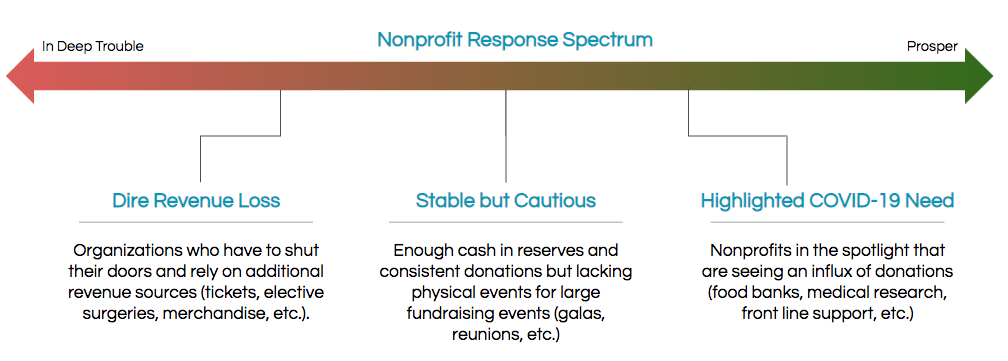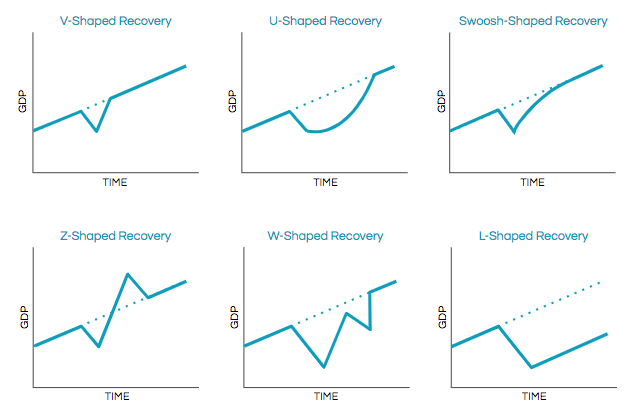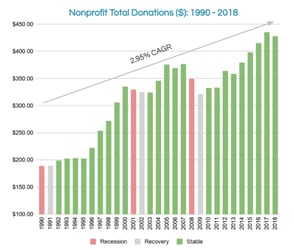In May, Windfall presented its thoughts on fundraising in a volatile market. We provided deep insights fueled by current and historical data to help guide development professionals through this turbulent time. Based on feedback from customers, we also wanted to provide sector-specific insights and hosted three panel discussions focused on: higher education, healthcare, and general nonprofits.
With 500+ nonprofits leveraging Windfall across the country, we invited all of our customers and the broader nonprofit community to join us for these dialogs. We’ve broken this post into:
- Fundamental questions for nonprofits
- Higher education
- Healthcare
- General nonprofit
- Common themes and insights
Fundamental Questions
Depending on your nonprofit organization’s focus, Windfall mapped out a general spectrum of responses to COVID-19:

Even if your nonprofit organization is continuing to successfully raise a good amount of donations, it does not necessarily mean that the organization is thriving financially. For example, hospitals have received generous donations from existing and new donors in recent months, but since many cannot perform elective procedures, they are suffering significant operating losses that cannot be covered completely through development efforts.
For our roundtables, we wanted to understand how various types of organizations are impacted by and reacting to the challenges from the pandemic. We organized the discussions around five key questions:
- Have you reforecasted FY2020? FY2021?
- Do you see a change in the department’s budget? When will this change?
- What are some changes in fundraising strategy? What has worked / not worked?
- What current data are you using to inform your decision process?
- How do you think the economy will recover? What impact does this have on your organization?
Each of the following sections discusses themes related to the questions above and some anecdotal stories from each roundtable.
Higher Education Roundtable
For our panel (find the recording here), we had the following individuals participate:
- Elizabeth Crabtree, VP of Administration & Operations at Brandeis University
- Danielle Vinson, Associate Director of Prospect Development at the University of Oregon
- Mohammed Dasser, Associate VP of Strategic Planning and Analytics at New York University
Budgets & Forecasts
With each of the institutions ending the fiscal year in the next 3 months, there was a lot of discussion around how they think about the impact to the department’s budget. Overall, the panelists found that there is more scrutiny where every dollar is placed; however, they did NOT cite significant impacts to their day-to-day budgets for this year (e.g. furloughs, layoffs, or cutting contracts with existing vendors).
Since students returning back to campus are a significant revenue source for each institution, the impact of COVID-19 is not fully known yet. Thus, each partnered with their finance teams to look at unique scenarios. For example, at NYU, they look at cash flow for the university and view finances holistically, while at Brandeis, they built a longer term forecast that was significantly impacted by COVID-19 and had to be reworked.
Fundraising Strategy
Each institution heavily relies on front-line fundraisers, so with no travel, their operations needed to change. Everything has moved to online forums, and organizations like the University of Oregon are leaning on faculty or research efforts to continue productive conversations. All of our panelists were also lucky to use platforms like EverTrue, which helps expand the fundraising capabilities of major gift officers.
Relying on Data
Each of the panelists recognized the value of data and how their organizations were fortunate to have tools, like Windfall’s Wealth Screening in place to help their teams focus. At NYU, they are taking the time to analyze data collected over the years and make it actionable. At Brandeis, they have found that Windfall’s wealth combined with our Trust Signal identified 3x the gift and are starting to rely on Windfall Propensity-to-Give Scores for additional segmentation and portfolio allocation.
Healthcare Roundtable
For our panel (find the recording here), we had the following individuals participate:
- April Witowski, Senior Director, Development Services at Children’s Hospital of Pittsburgh
- Richard Horne, Director, Prospect Development at Beth Israel Deaconess Medical Center (BIDMC)
- Tim Gale, Regional Director, Grateful Patient Philanthropy at Providence St. Joseph Health
Budgets & Forecast
Interestingly, in this panel, not one organization reforecast their fundraising projections at the time of the roundtable. This doesn’t mean that the institutions were not hurting; as we cited earlier, many hospitals are losing significant revenue without non-COVID-19 patients / procedures. That doesn’t mean that they aren’t thinking about it. For example, at Children’s Pittsburgh, while they did not change the fundraising forecast, they know the realistic projection may be reduced by ~25%, since in-person events have been canceled or postponed.
Even with unchanged forecasts, each institution mentioned budget freezes were common. In fact, BIDMC mentioned that many hospitals in Boston were losing money and had to go through furloughs recently. Everyone is looking at budgets and taking out expenditures that could help the overall institution weather the storm.
Fundraising Strategy
Similar to their higher education peers, each panelist described their shift to a digital infrastructure (webinars, town halls, and video-conference meetings). Some of the more traditional methods of fundraising, like direct marketing programs, continue to be extremely positive as prospects and donors responded at a similar or elevated pace compared to the prior year.
At Providence, for their grateful patient program, Tim found that engaging physicians as an extension of his team has worked extremely well and yields the highest engagement rate. BIDMC, similarly, has seen positive responses by first time donors either through their patient program or general stewardship. Conversely, Children’s Pittsburgh isn’t just relying on its existing population, but also reaching out to corporate foundations to help fill in the gap.
Relying on Data
Each panelist mentioned that looking closely at the existing infrastructure was one part of their strategies during this time. This means looking at their current databases and spending time on the tools and data that they already have access to. BIDMC relies on OKRs to drive their annual planning and puts analytics as a key function to help meet those needs.
At Providence, Tim and his team struggled with connecting patient and donor records together, but decided to leverage Windfall’s New Data Link product to improve identifying duplicates across the databases, yielding a 1,500% improvement. In addition, they leverage tools like Prysm to combine VOiP, machine learning, and wealth data in order to accelerate their grateful patient programs.
General Nonprofit Roundtable
For our panel (find the recording here), we had the following individuals participate:
- Karny Stefan, Chief Development Officer at Make-A-Wish Arizona (MAW-AZ)
- Jeremy Kraut-Ordover, Vice President, Individual Giving at Habitat for Humanity International (HFHI)
- George Pappas, Associate Head for Advancement and Strategic Initiatives at Canterbury School Fort Meyers
Budgets & Forecasts
The panelists here differed fairly significantly across the board since each had a different cause and fundraising approach. For example, at Canterbury School, the fundraising is fairly front loaded at the beginning of their fiscal year so if they did not raise the majority by December 31st, it would be problematic. That being said, pledges still need to be collected as they approach their fiscal year end. MAW-Arizona luckily was ahead of their goal when COVID-19 hit, but they were unable to host their annual Gala, which historically raises millions of dollars for the organization. At HFHI, the team is looking at forecasts on a monthly basis and will most likely hit plan this year, but sees that budgets are being scrutinized much more carefully.
Fundraising Strategy
Each of our panelists cited the importance of site visits, but with travel restrictions, the teams shifted to online / virtual fundraising. Instead of asking directly for gifts, the teams are focusing more on stewardship and cultivating smaller donors / prospects. At HFHI, the team is making sure that everyone in their portfolio is engaged since there is no excuse for a poor CRM with limited travel and no in person meetings.
For others in different industries like Canterbury School as an independent school, the summer is generally a slower time for the team to focus on their overall approach for the next year. As soon as the school year starts in August, their team gets to work but it’s a lot of the preparation the team is doing today that sets them up for success for the next fiscal year.
Relying on Data
Data is a central part of the day-to-day strategy for the panelists. Each of them cited the importance of leveraging internal and external data to empower their teams and accelerate conversations. Without site visits and in-person events, determining how to spend their time is a significant challenge.
At MAW-AZ, the team historically did not reach out to donors under $100; however, with Windfall’s wealth screening overlay the team was able to identify over 2,500 individuals within that donor database who had a net worth greater than $1 million. This helped provide a significant pipeline to the team during COVID-19. It has also helped the team focus and determine where they want to spend time building relationships, increasing engagement, and ultimately transitioning smaller gifts into larger ones.
Common Themes and Insights
It was incredibly refreshing and rewarding to speak with our customers to learn more about their approach in this tumultuous environment. We found some common themes and insights through our three roundtable discussions:
- The move to the digital world is here — instead of in-person visits, video conferencing and creative interactions has replaced traditional front line fundraising (for now)
- Many organizations are NOT reforecasting for this fiscal year, but are keeping a mindful eye on future years and cash flow
- There is a significant effort to keep donors and prospects engaged with valuable content without making a specific ask
- Data is being leveraged throughout the development organization to make informed decisions of where to spend time and effort
- All of the panelists mentioned giving donors space and respecting their boundaries as we all adjust to the “new normal”
While none of our customers wanted to predict the future and determine how the economy would recover, they were hopeful optimists that are all rooting for a quick and speedy recovery.
View customer roundtable on-demand recordings:
This article was co-authored by Arup Banerjee, CEO and Co-founder of Windfall, and Mike Vincent, VP of Customer Success, based on our customer roundtables hosted at the end of May 2020.







